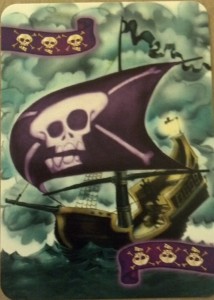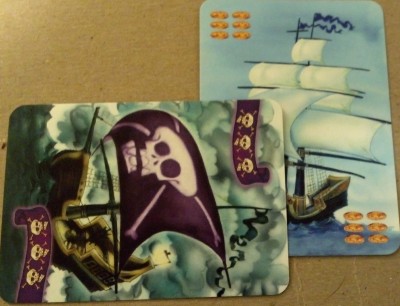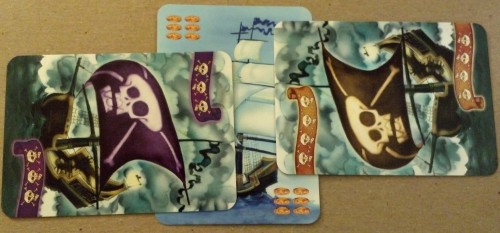Day… er…. Yar, it is a day:
Today be a good day fer sum pillagin’ and rum. I was hornswaggled outta me fancy new cutlass las’ night by Ol’ Pete. We best be headin’ fer some of them fancy rich galleons about lad, or it be a bad day for you…”
-Dread Pirate Jacob “Deadtooth” Wright, to his pet rat, Stinkwhiskers
The Premise
It’s dangerous time on the high seas! Players portray pirates trying to capture valuable merchant ships ripe with gold. After drawing cards, players take turns using them to plunder each other’s vessels for all they’re worth, yar. This continues until the deck runs out of cards, or until the pirates’ thirst for gold is satiated.
So it’s usually the deck running out.
Rule Synopsis
Loot’s contents consist of a deck of cards and a short rules explanation. As such, no set up is required. Simply shuffle the deck and deal six cards to each player. Most cards are either Merchant Ships or Pirate Ships. Merchant Ships vary in value between 2 and 8 gold coins, and the value is noted on the cards. The more of these ships that players collect, the more gold they have. When the game ends, the player with the largest treasure horde wins. Pirate Ships come in four colors and vary in strength between 1 and 4, as depicted by the number of skull-and-crossbones on the cards. Pirate Ships, obviously, are used to seize Merchant Ships. Lastly, there are a handful of powerful Captain/Admiral cards that work as Pirate Ships that can only be beaten by other Captains/Admirals..
Play structure is uncomplicated. Each player will choose one of several actions: draw a card, play a Merchant Ship, or attack a Merchant Ship with a Pirate Ship.
When playing a Merchant Ship, the player places it in front of them. That ship is now off on the high seas and fair game for plundering.
When attacking with a Pirate Ship, that player places it next to the Merchant Ship they’ve set their sights on. If that player makes it through the full round and back to their turn without any other player placing a stronger pirate ship on that Merchant Ship, they win the Merchant Ship. Essentially, if they’re the meanest scoundrel on the open ocean at that time, they keep the booty. Of course, in the meantime other players may attack the same Merchant Ship with a higher strength Pirate Ship – even the Merchant Ship’s owner. Ties keep the Merchant Ships in play.
The game ends when the deck runs out and someone’s hand is empty. Players count their Merchant Ship values, subtract any still in their hand, and the person with the most gold is the winner.
Privateer or Scallywag?
The most charming thing about Loot is that it doesn’t strive to stretch outside its humble gaming confines.
It also doesn’t need to. Sometimes a game works best with basic intent. Would you like to pretend to be a pirate and attack ships? Loot can do that. In fact, that’s all it does. So what if the entire concept of Loot can be summed up with a single Dominion card?
If you are looking for deep maritime back-stories and engaging plot, we suggest a game of 7th Sea instead as you won’t find those amongst Loot’s simple structure. This may disappoint some Immersionists. On the other hand, many Immersionists would argue that pirates don’t really need complex backgrounds anyway. Because, you know, you’re being pirates. Being a pirate rarely demands more than surface-level back story. There is no world building here, let alone building of any kind (sorry Architects), and it wears its pretense on its puffy sleeves.
So what do you with it?
You plunder matey!
Loot illustrates that a game doesn’t need to be complicated to be entertaining, and that is further bolstered by its short play time – about 20 minutes. Strikers will like the basic combat and clear objective, even if much of what you can do is determined by card draws. Socializers should enjoy the effortlessness that comes from playing something with actual rules while still getting most of your thrills out of bandying with other players in random pirate lingo.
Another creation of well-respected game designer Reiner Knizia (Carcassonne, Lord of the Rings), Loot epitomizes a game that can be both challenging and easy to grasp. There are some stratagems to play around with, such as when you play your own Merchant Ship or attack someone else’s. If you’re a Tactician looking for a little cerebral fix but aren’t able to bust out your favorite resource game, Loot won’t disappoint.
The Takeaway
Loot is enjoyable, simple, and short. Whether you are aiming for a game to pass the time, to play with a variety of ages and player groups, or even just to wind down after more elaborate games, Loot scratches the itch. With a little bit of something for a lot of different people, it’s a solid (and very affordable) get for most people’s gaming shelves. And honestly, who doesn’t love pirates (when ninjas aren’t involved)?
![]()
Cardboard Republic Snapshot Scoring (Based on scale of 5):
Artwork: 4
Rules Clarity: 5
Replay Value: 5
Physical Quality 4
Overall Score: 4.5
![]()
You can discuss this article over on our forums!



